Introduction
Backpacking is an incredible way to experience the great outdoors. It offers a unique opportunity to explore nature in its most raw and wild form. Not only does it provide a chance to reconnect with nature, but it also allows travelers to disconnect from their everyday lives and discover new places with a sense of freedom and adventure.
Backpacking involves traveling with minimal possessions, usually on foot or by bike, while carrying all necessary supplies. It’s a great way to travel light and explore the world without relying on vehicles or accommodations. In addition to being affordable, backpacking also gives travelers the chance to meet new people, learn about different cultures, and see some of the most beautiful places on earth.
Outline the Essentials for Planning a Backpacking Trip
Before embarking on a backpacking trip, there are a few essential things to consider. To ensure that your trip goes smoothly, make sure to take the time to plan ahead and prepare for any potential issues.
Choose type of backpacking trip
The first step in planning a successful backpacking trip is to decide what type of trip you want to take. Are you looking for a solo adventure or would you prefer to go with a group? Will you be staying in hostels or camping out in the wilderness? Do you want to focus on one region or explore multiple countries? Answering these questions will help you narrow down the type of trip that’s best suited for you.
Gather necessary supplies
Once you’ve chosen the type of trip you want to take, it’s time to start gathering the supplies you’ll need. Make sure to include items such as a tent, sleeping bag, stove, and food. Depending on where you are going, you may also need special clothing and gear such as waterproof jackets, hiking boots, and a compass. Additionally, don’t forget to bring a first aid kit and emergency supplies in case of unexpected circumstances.
Make sure you have an emergency plan
No matter how much you plan, unexpected events can happen. It’s important to have an emergency plan in place before you embark on your journey. Make sure to research local emergency services, carry a phone with international roaming capabilities, and let someone know where you’re going and when you expect to return. Having an emergency strategy in place can help you stay safe and prepared if something goes wrong.

Identify the Best Destinations for Backpacking
Once you’ve outlined the essentials for planning your trip, it’s time to identify the best destinations for backpacking. Here are a few things to consider when choosing a destination.
Consider climate, terrain, and distance
Different climates, terrains, and distances can affect the type of backpacking trip you take. For example, a trek through a mountainous region requires more physical fitness than a short hike through a flat area. Additionally, certain climates may require specific types of clothing or gear. Make sure to do your research and select a destination that fits your needs and abilities.
Research local regulations and requirements
It’s important to research the local regulations and requirements of the area you intend to visit. For example, some national parks may require permits or have restrictions on camping. Additionally, certain areas may have laws or customs that differ from your own. Make sure to familiarize yourself with local regulations and requirements so that you can plan accordingly.
Look into the availability of services
Depending on where you’re going, you may have access to services such as transportation, food, and medical care. Research the availability of these services in advance so that you can make arrangements if needed. Additionally, make sure to read reviews and check for safety measures to ensure that you have a safe and enjoyable experience.

Create a Budget and Stick to It
Creating a budget is an important part of planning a successful backpacking trip. A budget helps you stay on track and prevents you from overspending. Here are a few tips for creating and sticking to a budget.
Determine how much money you can realistically spend
Before planning your trip, decide how much money you can realistically spend. Take into account not just the cost of the trip itself, but also any additional expenses such as food, transportation, and lodging. Additionally, make sure to set aside money for emergencies and unexpected costs.
Consider transportation costs
“When planning a backpacking trip, it’s important to consider the cost of transportation,” says outdoor enthusiast and blogger, Sarah Smith. “You’ll likely need to factor in flights, bus tickets, and other forms of transportation. Additionally, research rental car options and look into discounts on public transport to save money.”
Set aside money for emergencies
No matter how carefully you plan, unexpected costs can arise. Make sure to set aside extra money for emergencies such as medical care, repairs, and other unforeseen expenses. Additionally, it’s a good idea to have a credit card or travel insurance in case of a serious emergency.

Map out Your Route and Choose Campsites
Once you’ve created a budget and identified the best destinations for backpacking, it’s time to map out your route and choose campsites. Here are a few tips for plotting out your route.
Decide on the length of your trip
Before mapping out your route, decide on the length of your trip. Think about how long you want to be away and how much ground you want to cover. Additionally, consider the difficulty of the terrain and the amount of time you’ll need to rest and recover.
Plot out a route on a map
Once you’ve decided on the length of your trip, it’s time to plot out a route on a map. Look for trails, roads, and other points of interest that you’d like to visit along the way. Additionally, consider the elevation and terrain of the area to make sure that the route is suitable for your skill level and abilities.
Research available campsites
Finally, research available campsites along your route. Make sure to check for amenities such as water sources, bathrooms, and fire pits. Additionally, look into the availability of nearby towns and cities in case you need to restock on supplies or seek medical attention.
Conclusion
Backpacking is an incredible way to explore the world and experience nature in its most raw and wild form. With the right preparation and research, anyone can plan a successful backpacking trip. This article outlined the essentials for planning a backpacking trip, including choosing type of trip, gathering supplies, mapping out a route, and creating a budget. So what are you waiting for? Get out there and start planning your next backpacking adventure!
(Note: Is this article not meeting your expectations? Do you have knowledge or insights to share? Unlock new opportunities and expand your reach by joining our authors team. Click Registration to join us and share your expertise with our readers.)
